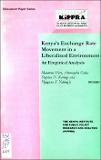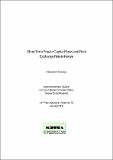| dc.date.accessioned | 2021-03-29T12:34:28Z | |
| dc.date.available | 2021-03-29T12:34:28Z | |
| dc.date.issued | 2000 | |
| dc.identifier.uri | http://repository.kippra.or.ke/handle/123456789/2756 | |
| dc.description.abstract | With globalization has come increased emphasis on an outward- looking
and a market-oriented economy. Consequently, the 1990s were associated
with a greater degree of liberalization of the financial, foreign exchange and
domestic goods markets in Africa. Liberalization of the foreign exchange
market in Kenya was gradual- from a fixed exchange rate regime to
crawling peg before a flexible or floating exchange rate regime was adopted
in the 1990s. This paper analyses factors that have influenced exchange
rate movements since the exchange rate market was liberalized in 1993.
Despite the policy change, empirical studies explaining exchange rate
movements in this period are still scant. Furthermore, the existing studies
on Kenya have concentrated on applying the traditional theoretical models
based on the interest rate and purchasing power parities. This paper adopts
a general empirical specification of the exchange rate equation encompassing
the interest rate and price differential, as well as current account balance
and net external inflows to explain the exchange rate movements in the
1990s. | en |
| dc.language.iso | en | en |
| dc.publisher | The Kenya Institute for Public Policy Research and Analysis | en |
| dc.relation.ispartofseries | DP/10/2001; | |
| dc.subject | Exchange rate | en |
| dc.subject | Foreign exchange market | en |
| dc.subject | Interest rate | en |
| dc.subject | Empirical models | en |
| dc.subject | Theoretical models | en |
| dc.title | Discussion Paper No. 10 of 2001 on Kenya's Exchange Rate Movement in a Liberalized Environment: An Empirical Analysis | en |
| dc.type | KIPPRA Publications | en |
| ppr.contributor.author | Were, Maureen ; Deda, Alemayehu & Ndungu, Njuguna S. | |




